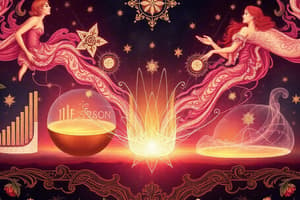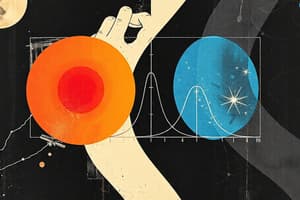Podcast
Questions and Answers
Which of the following statements accurately describes the relationship between the states of matter and energy transfer?
Which of the following statements accurately describes the relationship between the states of matter and energy transfer?
- Energy is absorbed during freezing and condensation.
- Energy is released during condensation and freezing. (correct)
- Energy is absorbed during evaporation and sublimation. (correct)
- Energy is released during melting and sublimation.
Which of the following best describes the reason why Group 0 elements (noble gases) are unreactive?
Which of the following best describes the reason why Group 0 elements (noble gases) are unreactive?
- They have a full outer electron shell. (correct)
- They have a very low atomic mass.
- They are all gases at room temperature.
- They are located on the right side of the periodic table.
Which of the following is NOT a change of state?
Which of the following is NOT a change of state?
- Decomposition (correct)
- Condensation
- Melting
- Sublimation
Which of the following statements accurately describes the difference between a mixture and a compound?
Which of the following statements accurately describes the difference between a mixture and a compound?
Which of the following is an example of a compound formed through covalent bonding?
Which of the following is an example of a compound formed through covalent bonding?
Which of the following methods can be used to separate elements from a compound?
Which of the following methods can be used to separate elements from a compound?
What is the difference between an atom and a molecule?
What is the difference between an atom and a molecule?
Which of the following is NOT a property of metals?
Which of the following is NOT a property of metals?
Flashcards
States of matter
States of matter
The three main forms of matter: solid, liquid, gas.
Solid properties
Solid properties
Has a fixed shape and volume with tightly packed particles.
Phase change
Phase change
Transformation between solid, liquid, and gas due to energy transfer.
Melting point graph
Melting point graph
Signup and view all the flashcards
Ionic bonding
Ionic bonding
Signup and view all the flashcards
Covalent bonding
Covalent bonding
Signup and view all the flashcards
Mixture vs. compound
Mixture vs. compound
Signup and view all the flashcards
Electrolysis
Electrolysis
Signup and view all the flashcards
Study Notes
States of Matter
- Matter exists as solids, liquids, and gases.
- Solids have a fixed shape and volume, with particles tightly packed and vibrating.
- Liquids take the shape of their container but have a fixed volume, with particles moving freely.
- Gases have no fixed shape or volume, with particles moving rapidly.
- Changes of state (e.g., melting, freezing, evaporation, condensation, sublimation) occur due to energy transfer.
- Temperature remains constant during phase changes (melting and boiling).
Melting Point Graphs
- Melting or boiling point graphs show temperature changes during heating.
- A flat section appears during changes of state (phase changes), where energy is used to break bonds rather than raise temperature.
The Periodic Table
- The periodic table organizes elements by atomic number.
- Elements in the same column (group) have similar chemical properties.
- Elements in the same row (period) have increasing atomic numbers.
- Metals are predominantly on the left of the table, non-metals on the right.
- Group 1 (alkali metals) are highly reactive.
- Group 7 (halogens) are reactive non-metals.
- Group 0 (noble gases) are unreactive.
Element Case Study: Oxygen (O₂)
- Oxygen (O₂) is a non-metal gas critical for respiration and combustion.
- It is present in water (H₂O) and the atmosphere.
Atoms, Elements, Compounds, and Molecules
- Atoms are the fundamental units of matter.
- Elements are substances composed of only one type of atom.
- Compounds form when two or more elements chemically combine.
- Molecules are groups of atoms bonded together.
Chemical Bonding
- Compounds are formed through chemical bonds.
- Ionic bonding occurs between metals and non-metals (e.g., NaCl).
- Covalent bonding occurs between non-metals (e.g., H₂O).
- Chemical formulas represent element ratios in compounds.
Separating Elements from Compounds
- Elements can be extracted from compounds through chemical reactions.
- Electrolysis separates elements (e.g., splitting water into hydrogen and oxygen).
- Thermal decomposition (e.g., heating copper carbonate) is another method.
Mixtures vs. Compounds
- Mixtures are combinations of physically combined substances.
- Compounds are substances with chemically bonded elements.
- Mixtures retain component properties and are separable by physical methods (e.g., filtration, distillation).
- Compounds have properties different from their elements and require chemical reactions for separation.
- Air is an example of a mixture of gases.
- Water (H₂O) is an example of a compound.
Studying That Suits You
Use AI to generate personalized quizzes and flashcards to suit your learning preferences.




